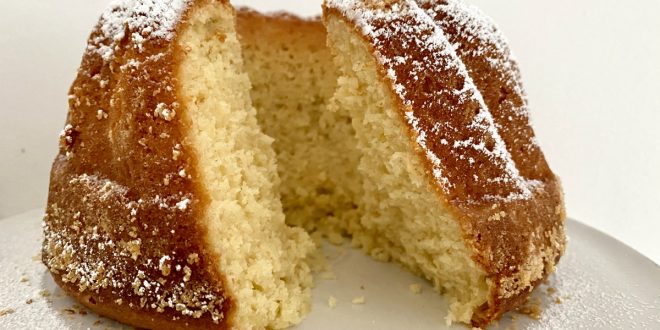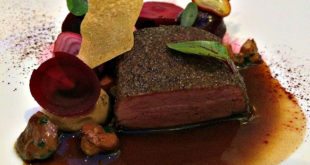What Is Gugelhupf?
Essentially, gugelhupf (or kugelhopf) is a yeast or sponge cake served with caster sugar sprinkled on top. Its characteristic form comes from the peculiar high creased cake form with a tube in the middle. What makes it taste special is the chopped orange or lemon peel used in the dough. Among the most popular varieties are cakes with raisins or the marbled gugelhupf, blending dark dough with chocolate with the original light dough.
In Austria, gugelhupf is one of the most popular Austrian desserts, and a classic for afternoon teas and Sunday breakfasts, at home or in Vienna’s coffeehouses. Especially Kurkonditorei Oberlaa, a Viennese cake shop chain, offers excellent marble Gugelhupf. When I was a kid, there was an eponymous Sunday breakfast radio show that my grandparents used to listen to. The Grand Hotel Wien, a Viennese luxury hotel, even offers its own signature Gugelhupf.
Because it’s a really easy cake I regularly bake Gugelhupf. What’s more, gugelhupf is not one of those creamy calory bombs and fits perfectly with afternoon coffee and tea. As for American Bundt cake recipes they share similar roots with our cake recipes: the German Bundkuchen. Here is all about our dessert favourite with some inspiration for preparing classic bundt cakes.
Where Does Gugelhupf Come From?
Early prototypes of the distinctive baking form were already used by the Romans, as excavations in the Roman settlement of Carnuntum close to Vienna demonstrate. During the Barbarian Migration following the destruction of the Roman Empire the baking forms disappeared. From the 15th century, Gugelhupf recipes started to spread quickly in what is today’s France, Switzerland, Southern Germany and Austria. In the meantime, we managed to make this cake a firm part of Austrian food.
Unlike Sacher Torte, Gugelhupf originated as a cake of the poor. During the 19th century, Habsburg Emperor Francis Joseph himself made the cake socially acceptable among the Austrian bourgeoisie. He liked the cake so much that he ordered it for his daily breakfast. Soon, bourgeois Viennese households adopted it as their favourite cake for afternoon tea, and the Gugelhupf entered the Empire’s crownlands in Eastern Europe.
According to historians, the first American bundt cake recipes originate from the early 20th century in Milwaukee, Wisconsin. Instead of the classic ceramic or enamel cake forms, they are made using aluminium forms, which were patented in 1950.
Baking Forms
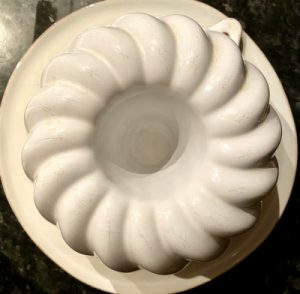 When you buy a gugelhupf cake tin, look out for the characteristic baking form with ridges and a tube in the middle. This extends the baking surface and helps the dough to bake evenly. Today’s most popular baking forms are made of the classic ceramic, of enamel, metal/teflon, heat-proof glass or silicone.
When you buy a gugelhupf cake tin, look out for the characteristic baking form with ridges and a tube in the middle. This extends the baking surface and helps the dough to bake evenly. Today’s most popular baking forms are made of the classic ceramic, of enamel, metal/teflon, heat-proof glass or silicone.
Although the classic diameter is 22 or 24 cm you can also get cute mini cake tins: Some arrange 6 to 15 cake forms the size of a muffin (6 to 12 cm) or, even smaller, a petit four (4cm) on a baking tray.
Classic Gugelhupf Recipes
Not only are the recipes below adequate for baking this Austrian cake but they make great Bundt cake recipes with a Central European touch. Most people, including me, use egg-based recipes since the yeast-based cakes are more difficult to prepare.
Classic Gugelhupf
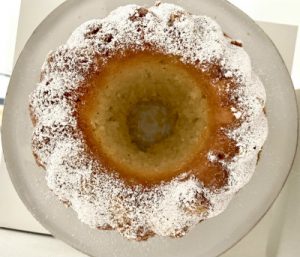 for 12 portions
for 12 portions
300 gr (10.6 oz) butter
240 gr (8.5 oz) flour
150 gr (5.3 oz) icing sugar
150 gr (5.3 oz) crystalised sugar
60 gr raisins
4 egg yolks
4 egg white
vanilla sugar
finely chopped lemon or orange peel
butter and flour for the pan
icing sugar to sprinkle
- Whisk the soft butter with the icing sugar until frothy.
- Whisk the egg whites and blend with the butter sugar mixture.
- Add the egg yolks, the vanilla sugar, the crystalised sugar, the flour, the lemon peel and raisins and mix well.
- Pre-heat the oven to 180 degrees Celsius (356 degrees Fahrenheit).
- Coat the cake form with butter and flour.
- Fill the dough into the form and bake for approximately 45-50 min.
- Let the cake cool out in the form before turning it out. This is important, otherwise you risk leaving part of the cake in the form. Be patient, this can take up to another hour.
- If the surface is very uneven, cut it straight using a knife.
- sprinkle with icing sugar, using a small sieve or tea strainer.
Marbled Gugelhupf
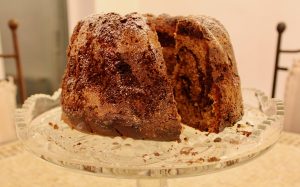 This recipe is popular because it produces a delicious moist cake.
This recipe is popular because it produces a delicious moist cake.
for 12 portions
250 gr (8.8 oz) flour
250 gr (8.8 oz) icing sugar
250 gr (8.8 oz) butter
5 eggs
8 gr (0.3 oz) vanilla sugar (equivalent to one pack in Germany and Austria)
15 gr baking powder (equivalent to one pack in Germany and Austria)
7 table spoons of milk
2 to 3 tablespoons of cocoa powder
20 ml (0.7 fluid ounces) rum
Separate egg yolks from egg whites and whisk the egg whites until stiff.
Whisk the butter, the icing sugar , the vanilla sugar and the five egg yolks until frothy.
- Add the flour, baking powder, milk and rum and mix well.
- Carefully stir in the beaten egg white.
- Coat the Gugelhupf form with butter and flour.
- Pre-heat the oven to 180 degrees Celsius (356 degrees Fahrenheit).
- Fill half of the dough into the baking form.
- Mix the cocoa powder into the remaining dough and add the dough to the form.
- Bake the cake for approximately 40 to 60 minutes. (After 35 minutes, pierce the dough with a fork to check whether it is done. If dough sticks to the fork, the cake needs to bake a little more.
- Like in the previous recipe, allow some time to let the cake cool out in the form before turning it out.
- sprinkle with icing sugar, using a small sieve or tea strainer.
Soft Cheese Gugelhupf
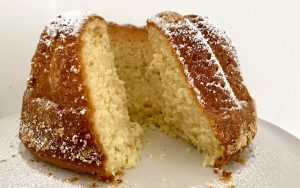 Because it creates a very fluffy cake this Gugelhupf recipe with ‘Topfen’ (soft cheese) is my favourite.
Because it creates a very fluffy cake this Gugelhupf recipe with ‘Topfen’ (soft cheese) is my favourite.
for 10 portions
250 gr soft cheese
250 gr icing sugar
250 gr butter
270 gr plain flour
30 gr corn flour
5 eggs
1 tbsp baking powder
1 tsp of vanilla extract
zest of 1 lemon
- First, whisk butter and egg yolks until creamy,
- add lemon zest with sugar.
- Stir the soft cheese until creamy
- add to the butter mixture spoon by spoon
- add the flour mixed with corn flour and baking powder spoon by spoon.
- Finally, carefully add the beaten egg whites.
Grease the Gugelhupf tin and cover it lightly with breadcrumbs. Then fill in the dough and bake in the oven at 160 degrees Celsius for about 60 min. Before serving the cake, sprinkle with icing sugar.
Variations Of The Classic Gugelhupf Recipe
There are about as many variations of the classic Gugelhupf recipe as the year has days. Essentially, they include a few extra table spoons of either chopped nuts; nougat creme; blueberries and yoghurt; ground almonds and bitter orange oil; or cold mulled wine, to name just a few. You can also pour chocolate sauce or a thin layer of icing on top, instead of the icing sugar.
find out how make Austrian Knödel in best dumpling recipes
back to Austrian Food
explore more Vienna Tourism Essentials
back to Vienna Unwrapped homepage
